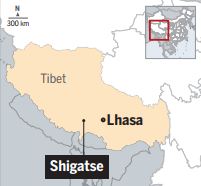Tibetan border city entices industry to go west

The government of Shigatse, a border city in the Tibet autonomous region, is using multimillion yuan subsidies to attract businesses and industries.
Subsidies up to 20 million yuan ($3.14 million) will be granted to industrial or business projects that can work within the Shigatse Economic Development Zone, such as high-technology industry and modern logistics services.
Those designated by the region's government or central government as key projects could receive as much as 30 million yuan.

Enterprises also will receive rewards for seeking financing through stock market initial public offerings, with the sum ranging from 1.5 million yuan to 7 million yuan.
The decision to provide the subsidies was disclosed late last month at a news conference held by the Shigatse city government in Shanghai-which has been paired with the Tibetan city since 1994 in a nationwide assistance program to boost development in Tibet.
More than 400 top workers from Shanghai-including government officials and professionals in different areas-have been sent to Tibet in eight groupings.
Shanghai will be a major adviser for the upcoming zone, which is 5 kilometers south of the urban area of Shigatse. The city was set up in 2014, bordering Nepal, Bhutan and India.
According to the layout unveiled at the news conference, the 36.3 sq km zone comprises two major functional zones-divided by the Jiaqu River, which flows across Shigatse-and will hold as many as 120,000 residents.
East of the river is the new city area, where the city government will be seated, along with schools, sports facilities, business and residential areas. West of the river is designated as the industrial area, equipped with logistics services and other support facilities.
The industries to be incorporated in the zone include logistics services, organic farming, drinking water industry, handicrafts, financial services and trade exhibitions, according to the Shigatse government.
By the end of next year, the zone's output value aims to hit 350 million yuan, accounting for up to 10 percent of that of Shigatse.
The Shigatse zone signals that industrial transfers are shifting further to the west, which benefits the whole country, said Sang Baichuan, an economics professor at the University of International Business and Economics in Beijing.
"East China, like Shanghai, excels in talents and capital, and there's a growing trend for the East to seek cooperation with the West in the industrial transfer," he said.
Sang also noted the focus of the national Tibet assistance program is gradually shifting to "forming blood" rather than "getting blood transfusions", which is evidenced by the economic development zone.
"Compared with lending money to the underdeveloped region in the very beginning, Shanghai now cultivates clusters of industries in Shigatse, which helps boost local economic development in a sustainable way," the professor said.
- HK bets on integrated hub to enhance TCM profile
- China widens net in battle against graft
- New US dietary guidelines trigger widespread concern
- China eyes space leap with record satellite filings
- Team formed to investigate the loss of 29 cultural relics
- Investigation into school uniforms confirms safety of waterproof layer





































